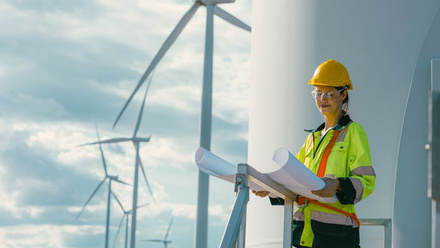Get talking – Efficiency in design
Kat Scott, Architects Declare Steering Group member and Sustainability & Regenerative Design Manager at dRMM, reveals how architectural practices across the globe have reset their approach to building design.

“Limiting global warming to 1.5oC would require rapid, far-reaching and unprecedented changes in all aspects of society,” the IPCC stated in 2018, and to keep global average temperature changes to this level, “global CO2 would need to fall by around 45% from 2010 levels by 2030, reaching net-zero around 2050”.
Construction and the built environment is currently responsible for 39% of global carbon emissions, so has a significant role in successful global decarbonisation. Of this, 28% arise from energy used to heat and power our buildings, or ‘operational carbon’, while 11% of global carbon emissions are associated with ‘embodied carbon’, or the carbon impact of materials used to construct and maintain our buildings.
It is this embodied carbon that the architecture profession has had a reckoning with over the last couple of years, realising the immediacy of the impact of the materials used in construction versus the more gradual, aggregate impact of operational carbon over the lifetime of our buildings.
UK Architects Declare was founded in 2019, with 17 founding architecture practice signatories. Now in Spring 2021, more than 1,080 UK architecture practices have signed up, and we’ve inspired other disciplines to ‘declare’ in the UK and in 26 countries worldwide, with over 6,000 companies now underneath the banner of ‘Construction Declares’.
Some of the declaration commitments include:
- Upgrade existing buildings for extended use as a more carbon efficient alternative to demolition and new build whenever there is a viable choice.
- Adopt more regenerative design principles in our studios, with the aim of designing architecture and urbanism that goes beyond the standard of net-zero carbon in use.
- Accelerate the shift to low embodied carbon materials in all our work.
This declaration, and its widespread uptake in the UK, has raised the bar for the specification of materials and approaches to architectural design. As Greta Thunberg famously states, 'every gramme of carbon counts' in the race to stabilise global temperatures, we see that every decision, every design team member makes counts. And in construction, really, we are talking more in the realm of tonnes of carbon, rather than grammes, emitted per m2 of typical buildings today.
In order for construction to decarbonise by the 2050 deadline, we need to get started today, if not yesterday. Lead times for construction projects are long, sometimes between five to 15 years, so the decisions we make now are locking us into a carbon pathway far into the future.
We must design now for the least impact possible – using materials that sequester rather than emit carbon. We must reuse materials and assets that already exist, rather than continually extracting virgin resources. In part, this need for reuse is that it is feasible in our industry, and so we ought to leave virgin resources left for processes where it is impossible to do otherwise. We know we need to design new buildings now with the potential for ease of deconstruction, dismantling at end-of-life, rather than designing in materials and systems that will only be able to be sent to landfill or incineration at end-of-life.
In 2020, Nature reports that anthropogenic mass has for the first time exceeded natural mass. Particularly, here in the UK, there is a need to face up to the climate and biodiversity twin crises with suitable urgency.
Simpler, efficient building design is the easiest way to reduce embodied carbon – by building less we emit less carbon. Retrofitting existing building stock is key, with Lacaton and Vassal, a practice well-known for retrofitting council housing this year’s Pritzker prize-winners. They state, “never demolish, never remove or replace, always add, transform and reuse!”
Architects also need to work closely with supply chains to understand how design decisions affect decarbonisation potential of materials. We need to educate ourselves better about where materials come from and how they are made, and whether they can be taken apart and used again. And, ultimately, at the start of every project we work on, we need to ask ourselves, do we really need this building in a climate and biodiversity emergency?







